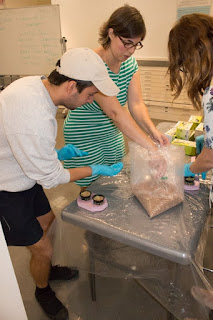David shared his personal work as well as collective work with Sally as part of Biome Arts.


Next we discussed some of the basics of hydroponics and aquaponics and some of the different methods to set up small and large scale hydroponic systems.
Then we created our own small-scale aquaponic aquaria using betta fish, aquatic plants and a floating raft system for hydroponic growing of wheatgrass, lettuce or herbs.
Styrofoam raft construction



Filling tanks with aquarium sand


Adding cholla wood and aquatic plants


Adding water and betta fish



Never be without a large bag of wheatgrass seeds - a bio-artist's best friend! Easy to grow with minimal light and a very quick growing cycle. Also a healthy addition to smoothies.
Constructing the rafts and adding seeds. In addition to wheatgrass we also had basil and lettuce seeds.
Getting acquainted with new friends/collaborators



A finished aquaponic tank by Sydney

HOMEWORK
- Choose from the two ideas discussed in private meetings this week and write a full proposal for your midterm project to your blog. Be sure to include 3 sketches/inspiration images as well as answer all the questions on the information sheet for the project.
- Familiarize yourself with the work of Mary Mattingly and the Swale website. Come to class with at least two questions to ask Mary when we meet with her on Swale
- Swale Plant Report - Part 1 due as blog post before class next week. Don't forget to "claim" your plants via blog post/check the blogs of your peers before choosing so that we do not end up with overlap. You should choose at least one plant from the list on the handout, you can also choose one from the full list of plants on the Swale website. Be prepared to give an oral presentation on your research to your peers during class next week.
INFORMATION FOR NEXT CLASS - 10/5
FIELD TRIP TO SWALE
WHAT: Field Trip to Mary Mattingly's Swale
WHERE: Swale is currently docked at Concrete Plant Park in the Bronx
WHEN: We will MEET AT SWALE AT 4PM
BRING:
- Full water bottle
- Sensible, close-toed shoes for walking on gravel paths
- Information from your Swale Plant Report for your oral presentation on your research (can be on your phone or paper)
- A pen/pencil and notebook with blank paper and writing surface for a design exercise
- Sun protection (sunblock, sunglasses, sunhat, etc., though it will be late in the day)
- Light jacket as it may get cool after dark, especially on the water
- Food to supplement a salad
Note on dinner: for this field trip we will not take a regular dinner break but instead will make a big salad together using plants collected from Swale and likely leave a little early. The salad will be more of a light meal than full dinner so if you would like to bring any supplemental food such such as personal snacks or better yet a dish to share that is acceptable (though not required).
Directions to Concrete Plant Park:
Concrete Plant Park can be accessed by taking the 6 train to Whitlock Ave. You should be able to see Swale docked in the Bronx River from the East of the subway platform as you arrive which will give you a sense of the direction you will be walking to reach it. Exit the station and turn right onto Westchester Ave. Walk about a block to the pedestrian entrance to Concrete Plant Park. You will need to walk a ways down the pedestrian path toward the large industrial structures (namesake of Concrete Plant Park) to reach Swale.
You should plan to arrive/be on board Swale by 4pm so please leave extra time for travel.














































